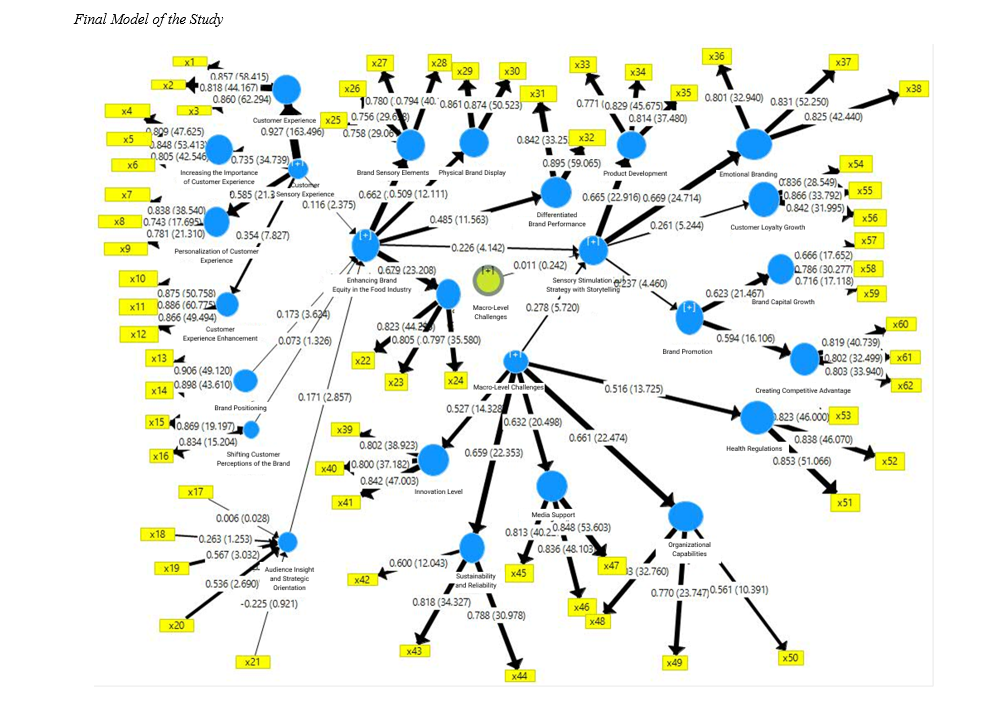Developing a Model for Enhancing Brand Equity in the Food Industry through a Sensory Marketing Mix and the BETTER Strategy Approach
Keywords:
Brand equity, sensory marketing, emotional branding, BETTER strategy, storytelling, food industry, customer experienceAbstract
This study aims to develop and validate a comprehensive model for enhancing brand equity in the food industry by integrating sensory marketing strategies and the BETTER framework. A mixed-methods research design was employed to investigate the interplay among key constructs such as sensory brand components, storytelling strategies, brand loyalty, customer experience, and emotional branding. The qualitative phase included expert interviews to contextualize the model, while the quantitative phase involved a structured survey administered to 384 participants across the food industry sector. Structural Equation Modeling (SEM) using SmartPLS was used to test the hypothesized relationships among variables. Reliability and validity were ensured through convergent validity (AVE), internal consistency (Cronbach’s alpha and composite reliability), and model fit indicators, including the GOF index. The results revealed that brand equity enhancement significantly predicts sensory brand elements (β = 0.663), physical brand display (β = 0.509), brand loyalty (β = 0.678), emotional branding (β = 0.670), and differentiated brand performance (β = 0.484), all with p < 0.001. Storytelling-based sensory stimulation positively influenced emotional branding (β = 0.670), customer loyalty (β = 0.268), and product development (β = 0.664). Customer experience strongly predicted customer sensory experience (β = 0.927) and perceived importance of experience (β = 0.735). However, the path from shifting customer perception to brand equity was not significant (p = 0.164). Macro-environmental challenges had a substantial effect on innovation (β = 0.527) and organizational enablers but did not significantly moderate the relationship between sensory storytelling and brand equity (p = 0.815). The overall model demonstrated strong fit (GOF = 0.573). The findings confirm that integrating sensory marketing with the BETTER strategy offers a powerful, multidimensional approach to enhancing brand equity in the food industry. Sensory experiences, emotional storytelling, and strategic agility collectively form the backbone of sustainable brand value creation in dynamic markets.
References
Abrar, M., Khan, A. S., & Xiang, L. (2022). Impact of Employee-Based Brand Equity on Customer-Based Brand Equity. 16-30. https://doi.org/10.4018/978-1-6684-3621-9.ch002
Ali, H., & Alquda, O. M. A. (2022). The Effects of Influencer Marketing on Overall Brand Equity Through Brand Awareness and Customer Brand Engagement. International Journal of Data and Network Science, 6(3), 651-658. https://doi.org/10.5267/j.ijdns.2022.4.007
Amin, F., & Nika, F. A. (2019). Impact of Brand Experience on Brand Equity of Online Shopping Portals: A Study of Select E-Commerce Sites in the State of Jammu and Kashmir. Global Business Review, 23(1), 156-175. https://doi.org/10.1177/0972150919836041
Anggraheni, A. F., & Haryanto, B. (2023). The Effect of Social Media Marketing on Brand Equity With Brand Experience as Mediation: Study on Uniqlo Product Users. European Journal of Business Management and Research, 8(3), 101-103. https://doi.org/10.24018/ejbmr.2023.8.3.1934
Catherine, S., Kiruthiga, V., Suresh, N. V., & Gabriel, R. (2024). Effective Brand Building in Metaverse Platform. 39-48. https://doi.org/10.4018/979-8-3693-1866-9.ch004
Dananjoyo, R. (2024). The Intervening Role of Brand Experience Customer Based Brand Equity (CBBE) in the Retail Industry. Prosiding Seminar & Conference FMI, 2, 731-747. https://doi.org/10.47747/snfmi.v2i1.2351
Ekklesi, F. G., & Sondakh, O. (2025). The Influence of Social Media Activities on Brand Loyalty: The Mediating Role of Brand Equity With the S-O-R Model on Netflix Customers. Ijeam, 1(6), 440-452. https://doi.org/10.60076/ijeam.v1i6.1128
Ghosh, S., & Roy, K. (2021). Identifying Brand Equity Dimensions and Measuring Its Relationship With Product Quality Dimensions: A Study on Juice Brands in India. International Journal of Management & Entrepreneurship Research, 2(7), 463-475. https://doi.org/10.51594/ijmer.v2i7.191
Gurupriya, S., & Joyce, D. R. (2025). A Study on Exploring Brand Equity as a Tool for Market Expansion on Aavin Products. Interantional Journal of Scientific Research in Engineering and Management, 09(04), 1-6. https://doi.org/10.55041/ijsrem43903
Huang, Y., & Bunchapattanasakda, C. (2023). Influence of Marketing Mix Strategy on Brand Equity Enhancement of Chinese Dried Forest Fruit Brands Based on Customer Mind Model. ABAC Journal, 43(4). https://doi.org/10.59865/abacj.2023.53
Jiang, J. (2023). The Brand Equity of Los Angeles Lakers. Advances in Economics Management and Political Sciences, 33(1), 240-245. https://doi.org/10.54254/2754-1169/33/20231661
Kazmi, S. H. A., & Zaman, S. U. (2024). Behavioral Biases of Promotion Strategies in Consumer Paradox Towards Brand Equity: Thematic Analysis. QJSS, 5(2), 495-511. https://doi.org/10.55737/qjss.v-ii.24322
Khandelwal, U., Kulshreshtha, K., & Tripathi, V. (2019). Importance of Consumer-Based Green Brand Equity: Empirical Evidence. Paradigm a Management Research Journal, 23(1), 83-97. https://doi.org/10.1177/0971890719844428
Magdy, A. (2024). Antecedents and Consequences of the Creative Food Tourism Experience: Brand Equity Insights. Tourism and Hospitality Research. https://doi.org/10.1177/14673584241276083
Midha, N., Yadav, S., & Srivastava, S. (2021). The Impact of Social Media Marketing on Consumer Based Brand Equity for White Goods Brands in India. Gurukul Business Review, 17(1). https://doi.org/10.48205/gbr.v17.1
Miller, D. (2024). Impact of Social Media Marketing on Brand Equity in the United States. International Journal of Marketing Strategies, 6(1), 36-47. https://doi.org/10.47672/ijms.1834
Nguyen‐Viet, B. (2022). The Impact of Green Marketing Mix Elements on Green Customer Based brand Equity in an Emerging Market. Asia-Pacific Journal of Business Administration, 15(1), 96-116. https://doi.org/10.1108/apjba-08-2021-0398
Nurhadi, M., Salsabillah, A. S., Suryani, T., & Fauzi, A. A. (2024). Peran Social Media Marketing Activities Dalam Membangun Brand Equity Dengan Mediasi Brand Trust, Brand Image, Brand Awareness Pada Produk SOMETHINC Di Indonesia. Performance Jurnal Bisnis & Akuntansi, 14(1), 241-256. https://doi.org/10.24929/feb.v14i1.2948
Piña, R. A. R., & Dias, Ã. l. (2020). The Influence of Brand Experiences on Consumer-Based Brand Equity. Journal of Brand Management, 28(2), 99-115. https://doi.org/10.1057/s41262-020-00215-5
Rodrigues, C. (2018). Multisensory Brand Experiences and Brand Love. 1-21. https://doi.org/10.4018/978-1-5225-2921-7.ch001
Sasivardhini, V., & Kalaivani, M. (2024). Investigating the Ascendancy of Brand Experience on Brand Equity: A Literature Review. International Journal of Science and Research Archive, 12(1), 625-634. https://doi.org/10.30574/ijsra.2024.12.1.0830
Sekar, S., Varki, S., & Elsantil, Y. (2024). Centrality of Sensory Attributes in Brand Extension Evaluations. Journal of Consumer Marketing, 41(5), 477-490. https://doi.org/10.1108/jcm-11-2021-5016
Šerić, M., Saura, I. G., & Descals, A. M. (2020). The Impact of Integrated Marketing Communications on Hotel Brand Equity. 63-91. https://doi.org/10.4018/978-1-5225-9282-2.ch004
Shariq, M. (2019). A Study of Brand Equity Formation in the Fast Moving Consumer Goods Category. Jindal Journal of Business Research, 8(1), 36-50. https://doi.org/10.1177/2278682118823306
Sharma, R. (2020). Building Consumer-Based Brand Equity for Fast Fashion Apparel Brands in the Indian Consumer Market. Management and Labour Studies, 45(3), 337-365. https://doi.org/10.1177/0258042x20922060
Suárez, M. G., & Guillén, M. J. Y. (2021). Making Sense From Experience: How a Sustainable Multi-Sensory Event Spurs Word-of-Mouth Recommendation of a Destination Brand. Sustainability, 13(11), 5873. https://doi.org/10.3390/su13115873
Tabelessy, W. (2024). Brand Love: Mediating Effect of the Relationship Between Social Media Marketing, Brand Loyalty and Brand Equity iPhone Brand Smartphone in Ambon City. Ijir, 2(5), 439-452. https://doi.org/10.59890/ijir.v2i5.1928
Yap, Y. W., & Suwarno, S. (2024). Analysis of the Influence of Social Media Marketing and Co-Creation Behavior on Brand Equity Through Mediation Brand Experience of Automotive Products in Indonesia. E3s Web of Conferences, 571, 06004. https://doi.org/10.1051/e3sconf/202457106004
Zhu, X. (2019). Research on the Impact of Content Marketing on Brand Equity. https://doi.org/10.2991/iafsm-18.2019.35

Downloads
Published
Submitted
Revised
Accepted
Issue
Section
License
Copyright (c) 2025 Mitra Mousadoabi (Author); Seyed Abbas Heydari; Sina Nematizadeh (Author)

This work is licensed under a Creative Commons Attribution-NonCommercial 4.0 International License.









